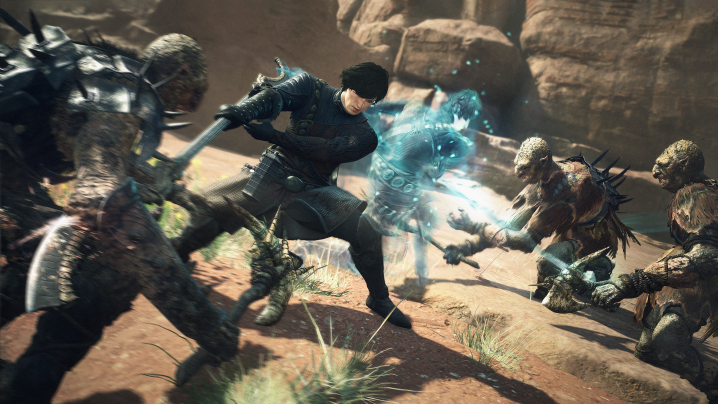
Dragon’s Dogma 2 intentionally gives players a hard time.
To create a gameplay loop that can produce a lot of unforgettable, organic moments, Capcom crafted many friction-filled systems for players to go up against. If players don’t equip themselves properly, have the right party composition between them and their pawns, or stray too far off the path they set for themselves, it’s possible for some ambush, giant monster, or another unintentional mishap to ruin a perfectly good quest.
That’s where a lot of the fun with Dragon’s Dogma 2 lies, but this approach to design often meant it can be more frustrating than fun at some moments, something I criticized in my review. For much of my playtime, I wasn’t sure how I felt about Dragon’s Dogma 2 as a whole. When I went for the true ending and discovered what was locked behind that path, though, the imperfect nature of Dragon’s Dogma 2 started to make a lot more sense.
This article contains spoilers for Dragon’s Dogma 2.
The final fantasy of Dragon’s Dogma 2
There’s a lot to uncover, and from the moment players can set out into its open world, Dragon’s Dogma 2 pulls no punches. Monsters are tough during the day and even more brutal at night, so you’ll always want a camping kit on hand and to be mindful of where the closest campfire to your current position is.
Early on, it’s often better to run rather than fight unless you’re very well equipped for a battle and the necessary healing afterward. If a quest’s objective hasn’t been denoted by any of those markers on your map and you’re deciding to venture out into unmarked territory alone, don’t be surprised when things go wrong and you lose a lot of progress from dying far after a save point.
Dragon’s Dogma 2 demands mastery of its system and puts up challenges for players to hone themselves on. But friction creates burns, and not all the marks Dragon’s Dogma 2 leaves on players feel justified. Things like antiquated save systems, sometimes clunky combat, and unforgiving difficulty don’t provide the wonder and escapism I often look for in fantasy games. To get that feeling more immediately, I recommend you play the likes of Baldur’s Gate 3 and The Legend of Zelda: Tears of the Kingdom over Dragon’s Dogma 2.

I stuck with Dragon’s Dogma 2, though, and eventually found the magic behind its design during the endgame. I went for the true ending, using the Godsbane Blade on the heart of a dragon rather than going for one of the two predisposed endings that Dragon’s Dogma 2 more obviously presented my Arisen.
By doing this, I essentially began the apocalypse as the world became “Unmoored” and untethered to the titular cycle that kept the game’s world going. Dragon’s Dogma 2 had transformed from a colorful fantasy game into a more dreary post-apocalyptic experience where I had twelve days to evacuate the entirety of Vernworth and Battahl and defeat a few final boss encounters marked by giant beams of light shooting into the sky.
The Unmoored World is essentially the endgame of Dragon’s Dogma 2, where players face the toughest enemies and get some of the best weapons and upgrades. It’s not only a neat narrative twist, either. The slight recontextualization made the same prickly gameplay mechanics in this post-apocalypse setting made them feel more fitting.
Combat already felt better because I’d progressed my favorite vocation by quite a bit, and the endgame quest objectives were clearer than most of the ones before the true ending. Resource management feels even more worrying when the town and vendors you can encounter are fewer and farther between, and I had to be a lot smarter about how often I rested because I had a 12-day time limit to account for. Saves are even more unforgiving in the Unmoored World, too; if you don’t like the most recent autosave, your only other option is to go back to the start of your time in the Unmoored World.

Somehow, those overarching threats and the survival-focused mechanics of Dragon’s Dogma 2 make much more sense in an apocalypse-like setting where players should have a constant sense of dread. That ire turned into determination, and I used all I had learned in the hours prior to complete these endgame quests as efficiently as possible. While I was beginning to lose patience with Dragon’s Dogma 2 by the time I’d gone for the true ending, exploring the Unmoored World revitalized my interest in the game.
I still think Dragon’s Dogma 2 is imperfect, as intentionally frustrating design is still frustrating design. Players need to be able to stomach that for a while in order to truly enjoy the game. Although Dragon’s Dogma 2 did not click with me initially, it finally did so in the Unmoored World, as I discovered I’d enjoy the game’s eccentricities more in a late-game, apocalyptic setting rather than an early-game fantasy one.
I can’t confidently recommend that everyone play the 20+ hours of Dragon’s Dogma 2 required to get to this point. Stop playing if you truly aren’t enjoying it; there are so many other great new games to try out. But perhaps my experience is the motivation you’ll need to stick with Dragon’s Dogma 2 during its worst moments and discover its flawed genius.
Dragon’s Dogma 2 is available now for PC, PS5, and Xbox Series X/S.



